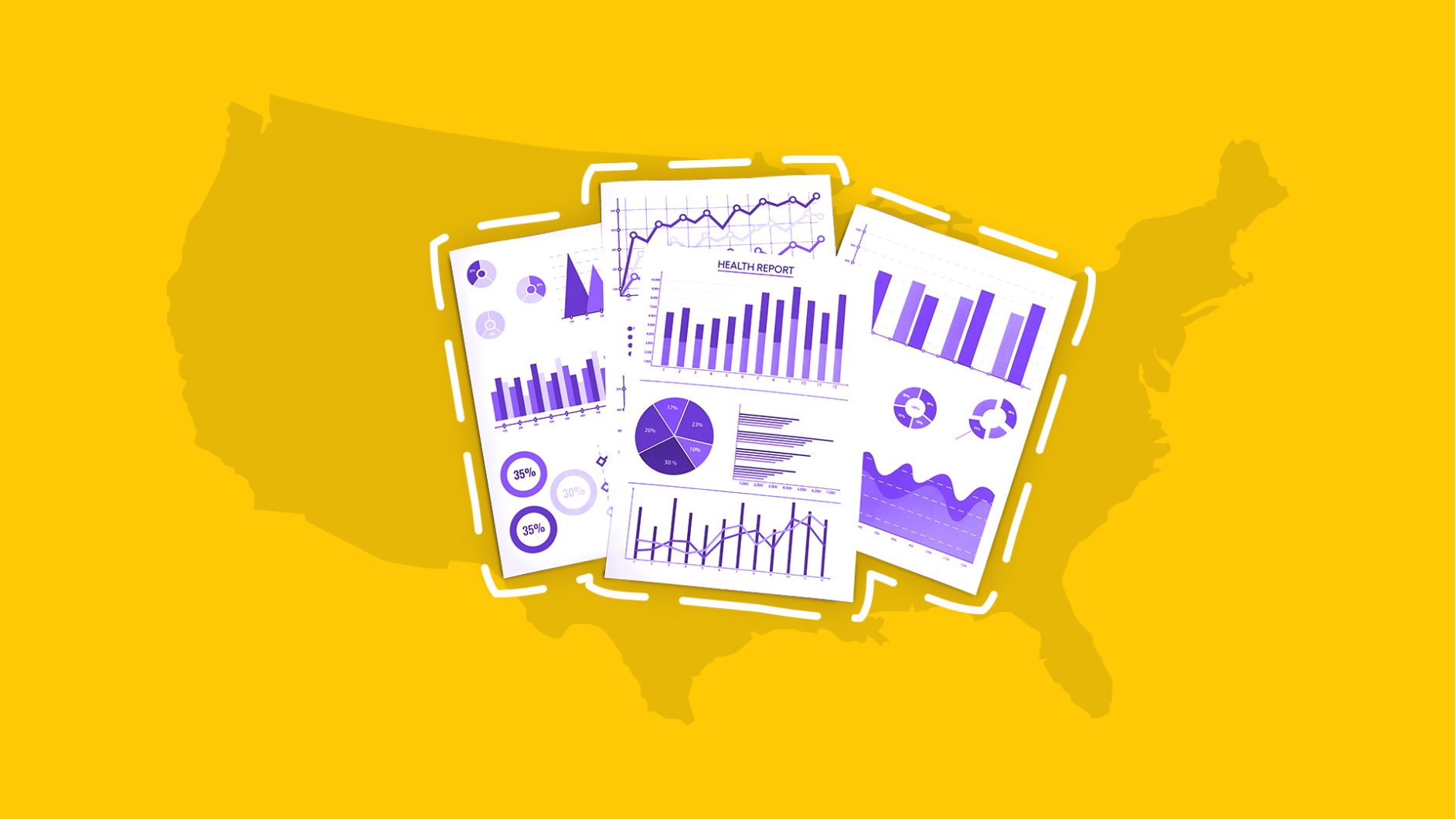What is anxiety? | How common is anxiety? | Worldwide anxiety statistics | Anxiety statistics in the U.S. | Anxiety statistics by sex | Anxiety statistics by age | Anxiety statistics by education level | Causes, risks, and treatments | FAQs | Research
All of us have felt anxiety one time or another, whether it be before a big test or public speaking. However, some people experience anxiety more than others. Disproportionate amounts of anxiety can sometimes be caused by an underlying issue, most commonly, an anxiety disorder. In this article, we will discuss the symptoms, causes, prevalence, and treatments for those managing anxiety.
What is anxiety?
Anxiety is the body’s response to worry and fear. “However, [anxiety] is not that simple as there is a wide range of how deeply anxiety affects people and to what extent it interferes with their quality of life,“ says Sanam Hafeez, Psy.D, a neuropsychologist in New York City and faculty member at Columbia University.
There is a multitude of anxiety disorders that cause anxiety, worry, and stress due to social interactions, personal health, work, or a particular phobia. Types of anxiety disorders include panic disorder, generalized anxiety disorder, agoraphobia (the fear of places that might cause feelings of anxiety), specific phobia, social anxiety disorder, post-traumatic stress disorder, obsessive-compulsive disorder, and separation anxiety disorder.
For many people with anxiety, their condition affects their ability to function in everyday life. For those with generalized anxiety disorder, symptoms can include restlessness, feeling on-edge, fatigue, difficulty concentrating, and muscle tension. Many anxiety disorders cause people to experience panic attacks, which are periods of intense fear triggered by an object or situation that can reach their peak within minutes.
“Anxiety affects people in a range of ways, often depending on the nature of the anxiety,” says Jill Stoddard, Ph.D, a psychologist based in San Diego. She says that avoidance of the triggers of anxiety is common ground for all anxiety disorders.
“For example, people with panic disorder may stop exercising or having sex to avoid increases in negative physiological symptoms; people with agoraphobia may avoid malls, crowds, driving, or flying—any situation where they might have panic symptoms and not be able to escape or get help,” says Stoddard.
Generalized anxiety disorder
Generalized anxiety disorder or GAD is the most common anxiety disorder. This is diagnosed after a person has anxiety, with little to provoke it, most days for a span of at least six months. This will begin to affect a person’s social, work, and home life. According to the National Institute of Mental Health (NIMH), the symptoms of GAD may include:
- Feeling restless or on-edge
- Feeling fatigued often
- Difficulty focusing
- Irritability
- Excessive feelings of worry that are difficult to control
- Difficulty with sleeping
Panic disorder
Panic disorders are characterized by unexpected and repeated panic attacks. People with panic attacks may try to avoid situations or constantly worry about when the next panic attack may happen. Symptoms of a panic attack include:
- Heart palpitations or increased heart rate
- Sweating or chills
- Shaking, trembling
- Shortness of breath
- Sense of terror
- Feeling a loss of control
Phobia-related disorders
Phobia-related disorders are fear or apprehensiveness about specific objects or situations. While some of these objects or situations may have reason to cause fear, the fear felt by the individual is disproportionate to the actual danger posed. There are a variety of phobia-related disorders. Some of the common ones include:
- Specific phobias cause a person to have an unreasonable or irrational fear of a specific object or situation. Some common phobias include flying, heights, or spiders. Symptoms of this disorder typically start in childhood.
- Social anxiety disorder, previously known as social phobia, is intense anxiety about being judged or rejected in social situations. Oftentimes, people with social anxiety disorder realize their worry is unreasonable, but still feel powerless in social situations.
- Agoraphobia, a person with agoraphobia needs to have two or more of the following symptoms for diagnosis: fear of public transportation, fear of open spaces or enclosed spaces, standing in a crowd, or being outside of the home alone. In severe cases of agoraphobia, a person can become homebound.
There are two other common disorders that have anxiety as one of the key symptoms but are no longer classified as anxiety disorders in the DSM-5. They include:
Obsessive-compulsive disorder
Obsessive-compulsive disorder or OCD is a disorder where individuals have recurring, unwanted thoughts, ideas, or sensations (obsessions) or the urge to do something repetitively (compulsions). Some people have obsessions and compulsions. Examples of OCD behaviors include:
- Checking objects repeatedly to reduce the fear of harming oneself. These things may include objects such as locks, ovens, lights.
- Repeating a name, phrase, or behavior because the individual fears something bad will happen if they are not completed.
- Cleaning compulsions may happen because there is a fear of contamination from things like dirt and germs.
- Ordering and arranging things in a symmetrical way or certain order to reduce discomfort.
- Intrusive thoughts or impulses may frequently reoccur causing feelings of anxiety.
Post-traumatic stress disorder
Post-traumatic stress disorder or PTSD happens when a person has difficulty recovering after a traumatic event. Symptoms may happen months or longer after the event. There are a wide variety of symptoms of PTSD, some of which include:
- Unwanted and recurrent distressing memories or flashbacks of the event
- Nightmares about the event
- Avoidance of things related to the event: people, places, or situations
- Hopelessness about the future
Anxiety vs. depression
It is important to note that there is a difference between anxiety and depression. In a very basic sense, anxiety is an excessive feeling of worry, where depression is excessive feelings of hopelessness and worthlessness. It is possible for someone to have both anxiety and depression at the same time.
How common is anxiety?
- In a 2020 survey, 62% of respondents reported experiencing some degree of anxiety. (SingleCare, 2020)
- An estimated 31% of all adults will experience an anxiety disorder at some point in their life. (Anxiety and Depression Association of America, 2020)
- An estimated 19.1% of adults in America had an anxiety disorder as of 2001-2003. (Harvard Medical School, 2007)
- Anxiety disorders are more prevalent in women than in men in the United States and around the world. (NIMH, 2017) (Our World in Data, 2018)
- Specific phobias are the most commonly occurring anxiety disorder, affecting more than 19 million adults in the U.S. (ADAA, 2020)
Worldwide anxiety statistics
- It is estimated that 264 million adults around the globe have anxiety. (World Health Organization, 2017)
- Of these adults, 179 million were female (63%) and 105 million were male (37%). (Our World in Data, 2018)
- The prevalence of all mental disorders increased by 50% worldwide from 416 million to 615 million between 1990 and 2013. (World Health Organization, 2016)
Anxiety statistics in the United States
The following statistics are specific to adults in the U.S.:
- Anxiety is the most common mental disorder in the U.S., affecting 40 million adults. (ADAA, 2020)
- The prevalence by state of mental illness ranges from the lowest in Florida (16.03%) to the highest (22.66%) in Oregon. (Mental Health America, 2017)
- The majority of adults with anxiety have a mild impairment (43.5%), 33.7% have a moderate impairment, and 22.8% have a serious impairment. (NIMH, 2017)
- Nearly half (47%) of survey respondents experience anxiety regularly. (SingleCare, 2020)
- 19 million adults experience specific phobias, making it the most common anxiety disorder in America. (ADAA, 2020)
- 15 million adults have social anxiety. (ADAA, 2020)
- 7.7 million adults have PTSD. (ADAA, 2020)
- 6.8 million adults have generalized anxiety. (ADAA, 2020)
- 6 million adults have panic disorders. (ADAA, 2020)
Anxiety statistics by sex
The following statistics are specific to people in the U.S.:
- Anxiety disorders are more common in females than in males. Anxiety affects 23% of female adults and 14% of male adults. (NIMH, 2017)
- Anxiety is also more prevalent in female adolescents than male adolescents (aged 13 to 18). As of 2001-2004, 38% of female adolescents had an anxiety disorder versus 26.1% of male adolescents. (Archives of General Psychiatry, 2005)
- Women are twice as likely to have generalized anxiety than men. (ADAA, 2020)
- The prevalence of OCD in women and men is equal, affecting 2.2 million adults. (ADAA, 2020)
Anxiety statistics by age
The following statistics are specific to people in the U.S.:
- Nearly one-third (31.9%) of adolescents (ages 13-18) had an anxiety disorder between 2001 and 2004. Of these adolescents, the 17- to 18-year-old age group was most affected. (Archives of General Psychiatry, 2005)
- Generalized anxiety was found to affect twice as many adults ages 26 to 49 when compared to the 50 or older age group. (SAMHSA, 2014)
- 30- to 44-year-olds were most affected by anxiety disorders as of 2017 followed by 22.3% of 18- to 29-year-olds and 20.6% of 45- to 59-year olds. (NIMH, 2017)
- 60-year-olds and older were the least affected age group as of 2017. (NIMH, 2017)
Anxiety statistics by education levels
- Americans with higher education are less likely to have an anxiety disorder. Anxiety affects 3.9 million adults who have less than a high school education, 3.3 million who have graduated high school, 2.8 million with some college, and 3 million who had a college education or more. (SAMHSA, 2016)
- One Canadian study found that for each additional level of education, people were 15% more likely to see a psychiatrist. (Healthcare Policy, 2007)
- Anxiety is the highest concern for counseling services in college. Of the college students receiving counseling services, 41.6% are seen for anxiety. (Association for University and College Counseling Center Directors, 2012)
Medical causes of anxiety
There are a variety of medical issues that can cause anxiety. Some of them include:
- Thyroid disorders like hyperthyroidism or hypothyroidism
- Heart disease
- Diabetes
- A side effect from medication
- Lack of oxygen or respiratory disorders including chronic obstructive pulmonary disease (COPD), emphysema, or asthma
- Illicit drug use or withdrawal from drugs/alcohol
- Irritable bowel syndrome (IBS)
RELATED: Does anxiety cause IBS?
Risk factors for anxiety
Lifestyle and environmental factors can increase the risk of having anxiety. They may include:
- Increased stress, which can come from a variety of sources. It may be due to a health condition, sleep disorders, or life situations such as work, school, financial troubles, relationship issues, or the death of a loved one. In SingleCare’s 2020 anxiety survey, nearly half (48%) of survey takers reported that stress at home was the cause of their anxiety. Another 30% reported workplace stress caused anxiety.
- Children and adults experiencing traumatic events are at a higher risk of developing an anxiety disorder.
- Low self-esteem, particularly in young people, can indicate anxiety.
- Genetics play a factor, too. One study found there is a moderate genetic risk of anxiety with a heritability of 30%.
- Major depressive disorder and other mental health disorders may often co-occur with anxiety.
- Substance abuse, including drug or alcohol use, can increase or worsen anxiety.
Treating anxiety
“Anxiety disorders are highly treatable, yet only 36.9% of those suffering receive treatment,” says Dr. Hafeez. There are three main ways to treat anxiety.
Therapy
Therapy, sometimes known as psychotherapy or counseling, can come in a variety of forms. It may be individual or group-based and can be given online, over-the-phone, or in person.
“One of the best treatment methods for anxiety is cognitive behavioral therapy (CBT). This helps patients understand the thoughts and feelings that influence behaviors,” explains Dr. Hafeez.
CBT takes an average of 12 to 16 weeks. The patient will learn skills that can be helpful in managing anxiety if they are continuously used.
Medications
Medication is another way to help relieve anxiety symptoms. Oftentimes a patient will use medication and therapy together for treatment. There are four main categories of drugs that a healthcare provider may prescribe to treat anxiety.
- Selective serotonin reuptake inhibitors (SSRIs): These medications, such as Zoloft, increase serotonin levels in the brain, which can help improve mood.
- Serotonin-norepinephrine reuptake inhibitors (SNRIs): These medications, such as venlafaxine, increase serotonin and norepinephrine levels in the brain.
- Benzodiazepines: These medications, like diazepam, treat physical symptoms of anxiety by reducing tension and promoting relaxation. Typically only used in short-term management of anxiety.
- Tricyclic antidepressants: These medications, including amitriptyline, help treat mood and physical symptoms. However, they do have some serious side effects.
Complementary and alternative medications (CAM)
CAM are treatments that are not typically considered part of conventional medicine, however, they have been found helpful in alleviating some anxiety symptoms. These are treatments that can be used in conjunction with therapy and medications. CAM includes:
- Acupuncture
- Meditation
- Exercise (especially yoga)
- Relaxation techniques
- Modifying diet by decreasing the intake of sugar, alcohol, and caffeine.
Support for anxiety and suicide
Suicide is the 10th leading cause of death in the U.S., according to the American Foundation for Suicide Prevention. In 2017, 47,173 Americans died by suicide, and there were an estimated 1.4 million suicide attempts. The relationship between anxiety and suicide has been studied for years, but results seem inconclusive. One study suggests that anxiety disorders are statistically significant but weak predictors of suicide ideation and attempts. Another found that panic disorder and PTSD are strongly associated with suicide attempts. Regardless of its relationship though, anyone who is seeking support can call the suicide prevention lifeline at 1-800-273-8255 or find resources on the ADAA’s website.
Anxiety questions and answers
What percentage of the world has anxiety?
In 2012, 7.3% of people in the world had an anxiety disorder, according to a systematic review published in the journal Psychological Medicine. The World Health Organization also supports this statistic, as it claims 1 in 13 people have anxiety.
What races or ethnicity are more prone to anxiety disorders?
Anxiety disorders have been found to be more prevalent in Euro/Anglo cultures, followed by Ibero/Latin cultures, then North African and Middle Eastern cultures.
How many people have anxiety in the U.S.?
Anxiety is the most common mental disorder, affecting 40 million adults in the U.S. population, according to the ADAA.
Who is most affected by anxiety?
Women are more likely to be affected by anxiety than men. In some disorders, such as generalized anxiety, women are twice as likely to have it as men.
What age does anxiety affect the most?
The age group most likely affected by anxiety is those from 30 to 44 years of age.
What percentage of students have anxiety?
Of students receiving counseling services, 41.6% are seen for anxiety treatment.
Why is anxiety so common now?
There is no one answer to why anxiety is more common now. It could be due to the decrease in the stigma surrounding mental health issues, poor sleeping or diet habits, or even the increase of social media use putting anxiety disorders on the rise.
Lea este artículo en español aquí.
Anxiety research
- 62% of survey takers experience anxiety, SingleCare
- ADAA anxiety facts and statistics, Anxiety and Depression Association of America (ADAA)
- Any anxiety disorder statistics, National Institute of Mental Health
- Investing in anxiety and depression treatment, World Health Organization (WHO)
- Depression and other common mental disorders, WHO
- State of mental health in America, Mental Health America
- Adults with less education more likely to have anxiety disorders, Substance Abuse and Mental Health Services Administration (SAMHSA)
- Income/education level and mental health services, Healthcare Policy
- The Association for University and College Counseling Center Directors annual survey, Association for University and College Counseling Center Directors (AUCCCD)
- National Comorbidity Study Replication (NCS-R), Harvard Medical School
- Mental health, Our World in Data
- Prevalence, severity, and comorbidity of 12-month DSM-IV disorders in the National Comorbidity Survey Replication, Archives of General Psychiatry
- Suicide statistics, American Foundation for Suicide Prevention
- The relationship between anxiety disorders and suicide attempts: Findings from the national epidemiologic survey on alcohol and related conditions, Depression & Anxiety Publication of ADAA
- Anxiety and its disorders as risk factors for suicidal thoughts and behaviors, Clinical Psychology Review
- Suicide support, treatment, and resources, ADAA











